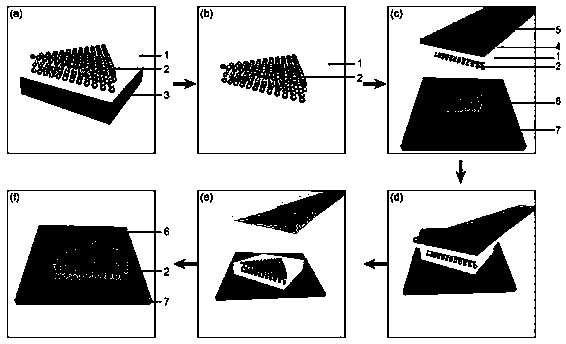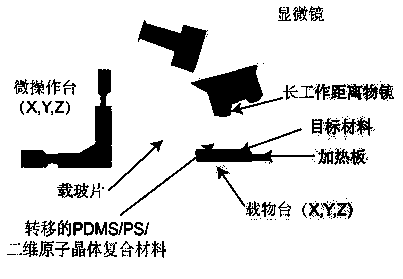A method for preparing a two-dimensional atomic crystal stack structure by transfer
A two-dimensional atomic crystal and stacked structure technology, which is applied in semiconductor/solid-state device manufacturing, electrical components, circuits, etc., can solve the problems of air bubbles, fragile samples, small sample area, etc., to reduce doping and damage, Residual glue treatment is easy and the effect of high separation repetition rate
- Summary
- Abstract
- Description
- Claims
- Application Information
AI Technical Summary
Problems solved by technology
Method used
Image
Examples
Embodiment 1
[0038] Positional transfer technology is suitable for the preparation of stacked structures (homojunction and heterojunction) of CVD-grown two-dimensional nanomaterials, so that tungsten disulfide (WS) grown on sapphire substrates 2 / Sapphire) localized molybdenum disulfide (MoS2) transferred to a silicon dioxide substrate 2 / SiO 2 ), so as to prepare a two-dimensional atomic crystal heterojunction as an example, which specifically includes the following steps:
[0039] (1) Toluene was used as a solvent to prepare a polystyrene (PS) solution, and the PS was dissolved by heating with magnetic stirring.
[0040] (2) Prepare dimethylsiloxane (PDMS), mix the main agent (A glue) and the hardener (B glue), remove the air bubbles in the mixed glue by centrifugation, pour it into the container, control the thickness to about 1 mm, and bake curing;
[0041] (3) subbed, in WS 2 / Sapphire surface is spin-coated with PS solution and heated for 30 minutes, then dried toluene solvent; ...
Embodiment 2
[0049] The experimental method is the same as in Example 1, and the single-layer MoS 2 Replaced by single-layer WS 2 , two layers of WS prepared by positioning transfer 2 homogeneous junction.
Embodiment 3
[0051] The experimental method is the same as in Example 1, the only difference is that the monolayer molybdenum disulfide is replaced by molybdenum trioxide nanosheets, and the WS prepared by positioning transfer 2 / MoO 3 Heterojunction.
PUM
| Property | Measurement | Unit |
|---|---|---|
| thickness | aaaaa | aaaaa |
Abstract
Description
Claims
Application Information
 Login to View More
Login to View More - R&D
- Intellectual Property
- Life Sciences
- Materials
- Tech Scout
- Unparalleled Data Quality
- Higher Quality Content
- 60% Fewer Hallucinations
Browse by: Latest US Patents, China's latest patents, Technical Efficacy Thesaurus, Application Domain, Technology Topic, Popular Technical Reports.
© 2025 PatSnap. All rights reserved.Legal|Privacy policy|Modern Slavery Act Transparency Statement|Sitemap|About US| Contact US: help@patsnap.com



